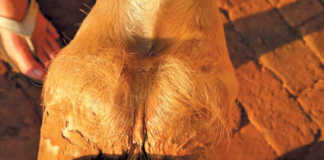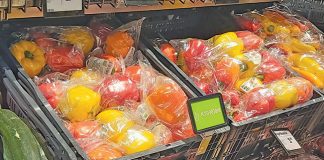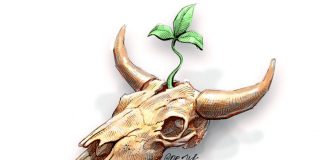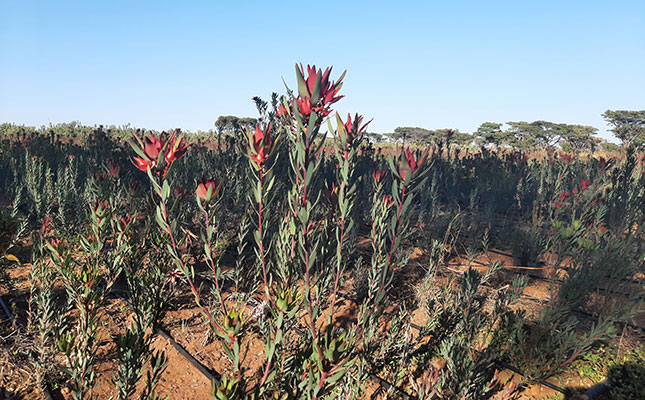
Photo: Pieter Dempsey
Nico Thuynsma grows a wide variety of fynbos on a 21ha farm in Cullinan, Gauteng. His business, Madibri, is spread out over four properties, each with its own microclimate suited to different cultivars.
When he started in 1997, the entire enterprise was centred on the production of cut flowers, but today this makes up only 30% of the business.
His main focus now is on the cultivation of fynbos, which he sells to other farmers and nurseries. The decision to switch from cut flower production to a nursery operation was motivated by the regular damage his flowers suffered from black frost.
This problem and the risk of hail made the nursery operation and production of plants, rather than flowers, a better option in the long run. Moreover, he says, proteas are slow growers.
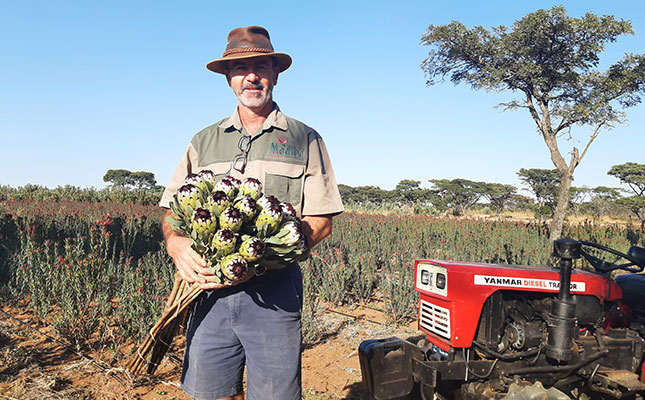
“If you lose your cut flowers to frost, it could mean you have your next crop only in two years’ time.”
The production of plants, in contrast, takes six to 12 months, and is done under cover to protect the young plants from frost and hail. This means a more stable cash flow.
The cut flowers that he does still produce are mostly rare cultivars such as natural hybrids. In total, Thuynsma produces around 37 varieties of protea, eight varieties of Leucospermum (pincushion), 14 of Leucadendron (conebush) and 29 of Erica (heath). He holds a bachelor’s degree in agriculture from the University of Pretoria, which he puts to good use, as he regularly consults with prospective and existing farmers, and presents workshops on fynbos cultivation.
Production and harvesting
Thuynsma grows about 5ha to proteas, which comprise 10 000 king, 3 000 Liebencherry, and 3 000 Susara proteas.
“We’re not able to plant much more than 5ha due to water constraints,” he says.
Different cultivars are planted on the four properties, with the hardiest being grown on those parts of the farm that experience the lowest temperatures.
According to Thuynsma, protea plants have a lifespan of around 12 years, and it is not good practice to replant old protea fields to protea again, as they are sensitive to root disease. In an effort to minimise the impact of root rot damage, Thuynsma makes sure that the soils in newly planted fields have adequate drainage. He also plants in rocky and sandy soils, which provide better aeration.
Thuynsma has replanted a field in which he used to grow proteas with about 550 pecan trees.
“They’re growing very well,” he says, “and if they produce well too, we have the capacity to increase plantings to 2 000 trees.”
The proteas are planted at an intra-row spacing of 1m, with 3m between rows. He carries out trials with cultivars, and experiments with planting density and planting in ridges.
“The ideal rows are 3m apart, which leaves enough room for a tractor to move through them, enabling spraying and cleaning to be carried out in the fields,” he adds.
Most of the protea cultivars yield between 10 and 30 flowers/plant/season and, depending on the cultivar and planting density, yields of between 30 000 and 60 000 flowers/ ha can be achieved in a single season.
The flowers are harvested twice a week in the off-season, and up to three times a week in peak season. They are cut to lengths of 50cm, 60cm or 70cm and bound in bunches of five, which are then placed in buckets of five bunches each and transported to the cut flower market.
Production economics
Conebush is planted at a density of 20 000 plants/ ha. “I’m able to plant this cultivar at such a high density because of its upright growth habit. We cut around 10 stems per plant, and if the price is good, we can realise a turnover of R400 000/ha.”
The input costs vary between R60 000/ha and R200 000/ha, but decent profits can be achieved within two to three years after planting, depending on the variety, says Thuynsma.
Frost remains one of his biggest challenges, and he is in the process of preparing an experiment aimed at increasing the Brix value of the plants (the measure of the sugar level in their sap) in a bid to make them more tolerant to extreme cold.
“This is done through strengthening the plant before the onset of winter by, for example, giving it additional potassium, magnesium, calcium and boron,” he says.
Soil analyses are conducted to determine which nutrients the plants require, and Thuynsma provides them only with what they need.
He adds that following the correct pruning method is essential, and each plant has to be individually pruned to maximise its potential. Incorrect pruning directly affects yield.
“Good-quality flowers are always in demand, and we focus on growing plants that can produce such flowers for the market.”
Propagating cuttings
Thuynsma propagates a variety of protea plants. The rooted cuttings are grown in
standard 30m x 10m plastic tunnels that each house approximately 100 000 cuttings. These cuttings, he says, need to be propagated and nurtured with great patience to ultimately achieve strong plants.
The cuttings are taken from plants in the field and dipped in an antifungal solution.
After this, they are dipped in a rooting solution, planted in polystyrene plant trays,
and kept under ideal conditions. Once the cuttings have rooted, they are planted into 1ℓ bags that are then either sold to farmers or grown to a size suitable for retail nurseries, which is normally a 5ℓ bag.
The process is highly labour-intensive: seven full-time employees produce the cuttings and plant them into the propagation trays.
“There are some losses with difficult varieties,” says Thuynsma. “From the 100 000 cuttings propagated in a tunnel each year, between 40% and 50% are lost, which means that only 50 000 to 60 000 cuttings will root.”
One of his biggest mistakes, recalls Thuynsma, was using fertiliser in his planting mix without testing it first. The result was 5 000 dead plants.
“We learn from our mistakes, and I now take far more care with measuring and recording various aspects of production. This provides valuable information for future production decisions.”
There are bound to be many; his plans include expanding cut flower production, and producing the finest rooted protea cuttings in the world.
Email Nico Thuynsma at [email protected].








